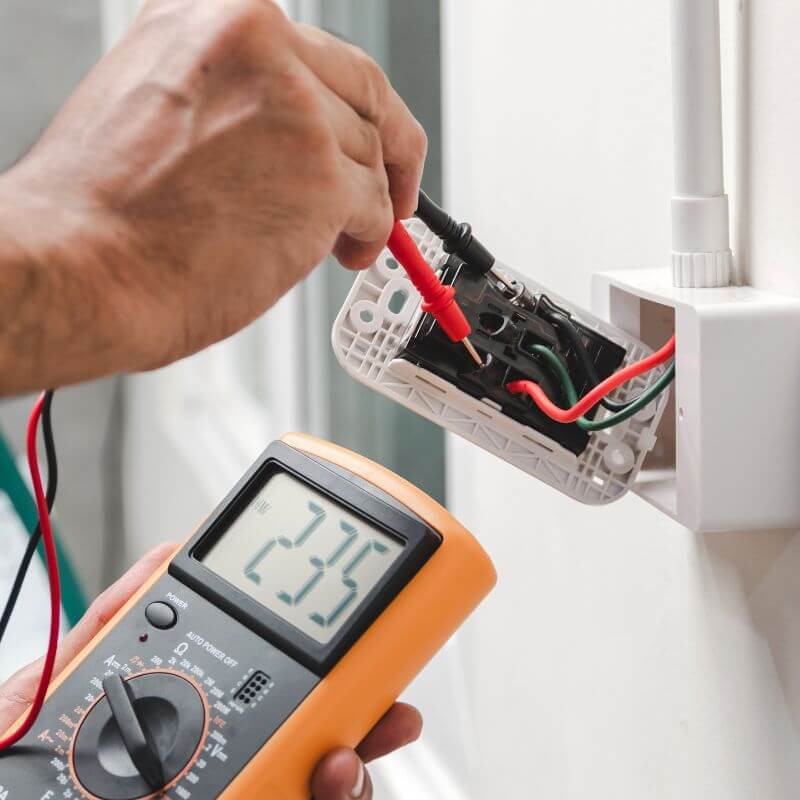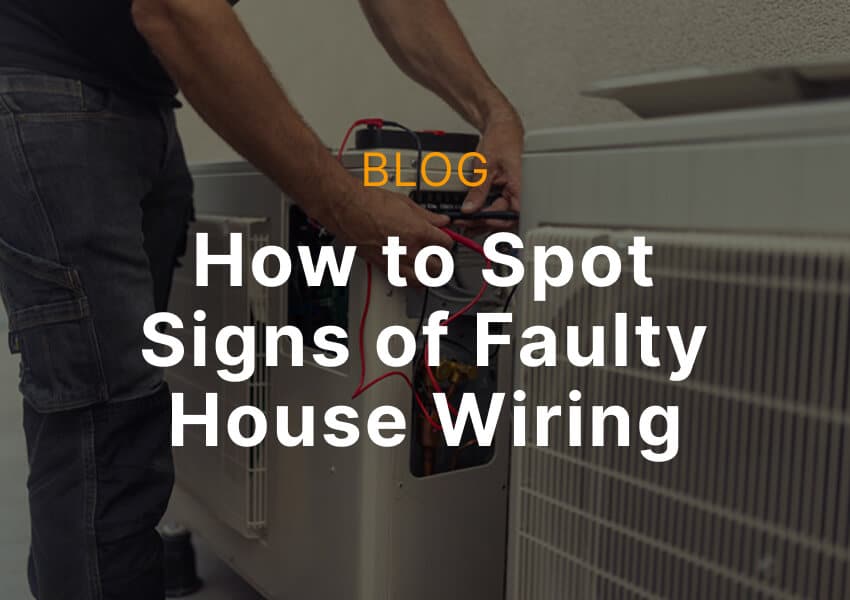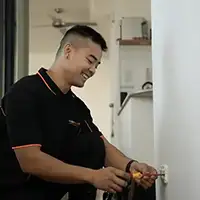Electrical problems often start quietly. A flicker here, a warm outlet there. These small issues can quickly become serious safety hazards. Understanding the signs of faulty house wiring helps protect your property and family from fires, power outages, and costly damage.
Old or damaged wiring is one of the most common causes of electrical fires in Australian homes. By learning to recognise early warning signals, you can act quickly, contact a licensed residential electrician, and keep your electrical system safe and reliable.
Why Faulty Wiring Is Dangerous
Even minor electrical faults can lead to major safety issues if ignored. Faulty wiring puts your home, appliances, and family at risk of shocks, fires, and unexpected system failures. Here’s why it matters:
Fire and Shock Risks
Faulty or ageing wiring can overheat and cause electrical arcing, which may ignite surrounding materials such as insulation, timber frames, or plasterboard. These sparks are a common reason behind residential fires in Australia, particularly in older Sydney homes built before modern standards were introduced.
Electrical shocks can also occur when exposed wires or damaged insulation make contact with conductive surfaces. These risks are life-threatening and highlight the importance of quick, professional intervention.
Damage to Appliances
Unstable wiring causes inconsistent voltage, which can damage household appliances. Frequent surges or low voltage affects items like fridges, TVs, and computers, reducing their lifespan and performance.
When these surges continue unnoticed, you could be wasting energy, damaging sensitive electronics, and increasing your power bills. If your lights flicker when you use heavy appliances such as air conditioners or heaters, it’s time to have your wiring inspected by licensed electricians in Sydney.
Hidden Structural Hazards
Faults hidden within walls or ceilings can go unnoticed until major damage occurs. Heat from deteriorating cables may weaken insulation, melt junction boxes, or create small fires that spread behind walls.
Because these problems are invisible, homeowners often underestimate the danger. Early detection through a professional inspection prevents costly repairs and maintains the long-term safety of your home.
Legal and Insurance Concerns
In Australia, electrical work must comply with AS/NZS 3000 standards. If a fire results from unlicensed repairs or ignored faults, insurance claims may be denied. Failing to meet compliance requirements can also reduce your property’s value or delay a sale.
Ensuring regular inspections and professional rewiring protects your home’s safety, maintains compliance with Australian law, and gives you the confidence that your electrical system is secure.

Common Warning Signs of Faulty Wiring
Recognising early warning signals can prevent dangerous electrical problems before they escalate. Each symptom offers valuable insight into your wiring’s condition and safety. Here are the most common signs of faulty house wiring every Sydney homeowner should know and never ignore:
Flickering or Dimming Lights
If you notice lights that flicker or dim unexpectedly, it could signal loose connections, outdated cables, or overloaded circuits. Flickering lights faulty wiring issues often appear when appliances like kettles or heaters draw too much current, causing the lights to fade.
While many people assume it’s a bad bulb, frequent flickering means the wiring behind your switches or ceiling fittings may be deteriorating. Left unchecked, this can overheat cables and create electrical fires. Our licensed electricians provide a full range of electrical services including testing circuit loads, tightening loose terminals, and upgrading cables to restore safe operation.
Burning Smells or Heat
A burning smell electrical wiring hazard is one of the most serious red flags. It often indicates that insulation is melting or that wires are overheating behind walls. Sometimes you might also feel warmth near outlets or light switches. These are clear warnings that something is wrong.
Turn off power at the switchboard immediately and contact an electrician before using the circuit again. Acting fast can prevent a full electrical fire and protect both your property and family.
Warm or Discoloured Outlets
Outlets that feel hot to touch, appear brown, or show small scorch marks can point to internal arcing or loose terminations. Hot or discoloured power outlets mean electricity is jumping gaps instead of flowing smoothly.
This arcing generates extreme heat that can ignite plastic casings. If you notice this, avoid plugging anything in until a professional assesses the problem. Replacing outlets and tightening wiring connections are inexpensive fixes compared to the cost of fire damage.
Circuit Breakers Tripping Frequently
When your circuit breaker keeps tripping, your electrical system is warning you about overload, short-circuiting, or ground faults. While flipping the switch back may restore power, constant tripping is not normal. It can signal an undersized circuit, ageing wiring, or moisture ingress.
If you live in an older home around Epping or Parramatta, this problem is especially common. An electrician can identify the source, rebalance circuits, and upgrade your switchboard to handle today’s power demands safely.
Buzzing or Crackling Sounds
Electrical noise coming from walls, ceilings, or outlets suggests current arcing between damaged wires. This subtle buzzing is one of the most ignored warning signs faulty wiring in home systems. Do not overlook it. Turning off power and arranging an inspection can stop a small issue from escalating into serious electrical failure.
Old or Outdated Wiring
Many properties built before the 1990s still rely on outdated wiring that wasn’t designed for modern electrical loads. These old house wiring issues Australia wide are often hidden until renovation work reveals brittle insulation or ungrounded circuits.
If your home still has porcelain fuses or cloth-covered cables, it’s time for a full rewiring assessment. Modern wiring is safer, more energy-efficient, and compliant with current Australian standards, reducing both fire risk and electricity waste.

How to Tell If Your Wiring Is Faulty and When to Call for Help
Electrical faults aren’t always easy to spot. Some start small and stay hidden behind walls, slowly causing damage that only becomes obvious when lights fail or power trips. Knowing how to tell if wiring in the house is faulty helps you act before it becomes a real hazard.
Check for Inconsistent Power Supply
If your lights flicker, appliances shut off suddenly, or sockets randomly stop working, there may be a deeper problem with your circuits. These symptoms are early signs of faulty electrical wiring that can quickly worsen. They might indicate weak connections, undersized cables, or outdated fuses.
Ignoring these signs could lead to overheating, fire risk, or expensive equipment failure. A licensed electrician can test voltage levels, identify weak points, and ensure your wiring safely supports modern household demands.
Notice Heat or Burning Smells Quickly
If you detect a burning odour around outlets or switches, act immediately. These smells often mean insulation is melting or that wires are heating behind plasterboard. They’re unmistakable signs of faulty house wiring that demand fast action. Turn off power at the switchboard and call a professional straight away.
In many Sydney homes, these issues appear after years of overloading or when DIY wiring has been done incorrectly. Quick response prevents small problems from spreading into full electrical fires.
Observe Strange Sounds or Vibrations
Hearing faint humming, crackling, or vibrating behind walls is not normal. It may be electricity arcing between damaged conductors or terminals. This can create both sound and vibration as energy escapes the circuit.
A professional electrical safety inspection Sydney can pinpoint these problems before they escalate. During an inspection, electricians use thermal imaging and circuit testers to detect hidden hot spots and ensure your home meets AS/NZS 3000 safety standards.
Don’t Delay Calling an Electrician
It’s always better to call a licensed electrician early rather than waiting for a failure. When in doubt, seek expert help. Knowing when to call an electrician for wiring faults can prevent fires, shocks, and property damage.
Many Sydney homeowners schedule annual checks for peace of mind. Licensed electricians not only repair wiring faults but also test safety switches, replace worn fittings, and document all work for compliance and insurance. Acting early ensures your home remains safe, efficient, and legally compliant.
Preventing Future Electrical Problems
The most effective way to avoid costly and dangerous wiring issues is by staying proactive. Spotting the signs of faulty house wiring early is essential, but long-term prevention ensures your home remains safe, efficient, and compliant with Australian standards.

Schedule Regular Electrical Inspections
Every home should undergo a professional wiring inspection at least every five years, or sooner if you notice unusual electrical behaviour. Certified electricians can detect loose joints, frayed insulation, and damaged circuits before they become serious problems.
A detailed inspection also includes switchboard testing, earthing checks, and thermal imaging to identify hidden faults. In older Sydney homes, these assessments are particularly valuable because wiring systems often pre-date current safety codes.
Avoid Overloading Power Points
Plugging multiple high-powered appliances into one socket is one of the fastest ways to overheat circuits. Extension cords and power boards are useful for short-term use but should never become permanent solutions. Spread large appliances such as fridges, heaters, and washing machines across separate outlets.
If your family uses many devices, have additional power points installed by a licensed electrician. It improves convenience, prevents overheating, and keeps your electrical system balanced and safe.
Upgrade Old Wiring and Switchboards
Many homes built before the early 2000s still use fuse boxes or wiring that no longer meets Australian electrical standards. Upgrading to a modern switchboard with circuit breakers and RCBOs significantly improves safety. These devices instantly cut power during a fault, preventing shocks and fires.
An upgrade also supports today’s energy demands from appliances, solar systems, and electric vehicles. If your lights dim when you use the microwave, or your breakers trip regularly, talk to an electrician about updating your system.
Hire Licensed Electricians Only
Electrical repairs and installations must only be carried out by qualified professionals. DIY wiring, even for simple fixtures, is not only unsafe but also illegal in Australia. Licensed electricians follow strict AS/NZS 3000 standards, ensuring all work is tested, certified, and safe for long-term use.
Professional service also protects your insurance coverage and property value. Always check your electrician’s licence number before any job, and keep compliance certificates for future reference.
Create a Safe Maintenance Routine
Prevention also means paying attention to everyday use. Replace damaged cords immediately, keep water away from sockets, and unplug unused appliances during storms.
These small habits reduce stress on circuits and extend the life of your electrical system. Encourage family members to report flickering lights or burning smells early so problems can be fixed before they grow.
Need Help with Faulty Wiring in Your Sydney Home?
If you’ve noticed any of these warning signals, don’t wait until the problem worsens. Faulty wiring can escalate quickly, risking your family’s safety and your property’s condition.
Call Powerhub Electrical on 0400 332 331 for professional inspection, repairs, and rewiring across Epping, Parramatta, and surrounding Sydney suburbs. Our licensed electricians are available 24/7 to deliver safe, reliable, and fully compliant electrical solutions that keep your home powered and protected.





